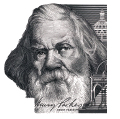Sir Henry Parkes (1815–1896)

Politician known as the ‘Father of Federation’.
Sir Henry Parkes was described during his lifetime by The Times of London as ‘the most commanding figure in Australian politics’. He was a political survivor, evidenced by the fact that he was premier of colonial New South Wales five times between 1872 and 1891. His political life spanned the second half of the 19th century, from the establishment of responsible self government in 1856, through the era of faction politics characterised by shifting alliances, to the advent of the party system. He was accorded the epithet ‘Father of Federation’ for his leadership in advancing the cause for nationhood during the last decade of his life.
1815: Born in Warwickshire, England, in 1815, Parkes became a bone and ivory turner.
1839: He emigrated to New South Wales and drifted into journalism after fitful progress in his trade. His literary and political writings belied his lack of formal education. While in England he had taken up the cause of political radicalism, an interest he continued in the colony.
1848: He campaigned for universal male suffrage and played a prominent role in the campaign against the resumption of convict transportation to New South Wales.
1850–1858: He was editor and proprietor of The Empire newspaper, an organ of liberal opinion.
1854: Parkes won a seat in the Legislative Council at the elections of 1854.
1856: He was elected to the newly established Legislative Assembly in the first Parliament under responsible self government.
1877: He was knighted in 1877.
1880: Parkes' legislative and secular reforms in education, particularly the 1880 Public Instruction Act, which strengthened the state education system, were controversial and aroused sectarian discord.
1887: In anticipation of the forthcoming Centennial celebrations, Parkes unsuccessfully sought to have New South Wales renamed Australia.
1889: On 24 October 1889, at a reception in his honour at the Tenterfield School of Arts, Parkes delivered an address to his former constituents that was a clarion call for Federation. In this landmark speech he declared that the time was right for a convention of representatives from all the colonies to be convened ‘to devise the constitution which would be necessary for bringing into existence a federal government with a federal parliament for the conduct of national undertaking’.
1890: Parkes convened the 1890 Federation Conference in Melbourne as a precursor to the 1891 National Australasian Convention in Sydney.
1891: The 1891 National Australasian Convention in Sydney is where the first draft Bill of the Constitution was written. It was also there that he proposed the name ‘Commonwealth’ for the unified colonies.
1896: Parkes died at his home ‘Kenilworth’ in the Sydney suburb of Annandale on 27 April 1896, and was buried at Faulconbridge in the Blue Mountains. Married three times, his first and second wives had predeceased him. He was survived by his third wife, Julia, and numerous children from the marriages.
1901: One of Parkes' many legacies to the citizens of New South Wales was Centennial Park, a fitting site for the proclamation of the Commonwealth of Australia on 1 January 1901. Memorials to Sir Henry Parkes include the suburb of Parkes in Canberra, which is home to the Federal Parliament, and the central western New South Wales township of Parkes, both of which are named in his honour.
1996: On the 100th anniversary of his death, the Royal Australian Mint launched a general circulation $1 coin to commemorate him ‘officially’ as the ‘Father of Federation’.
The personal papers of Sir Henry Parkes, including his voluminous correspondence, are held in the Mitchell Library, State Library of New South Wales. They constitute one of the premier documentary collections of Australia's political heritage.
Assistance from the State Library of New South Wales in the preparation of this biography is acknowledged.
Further information is available in Notable Australians.